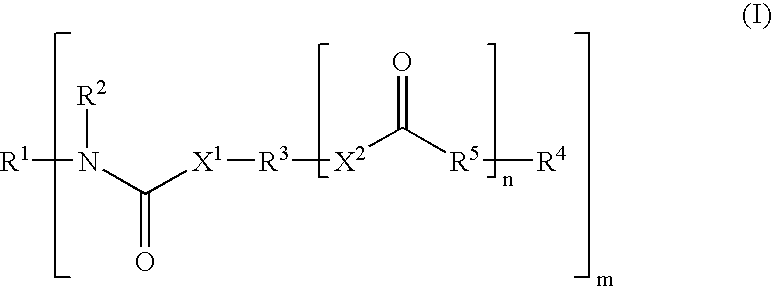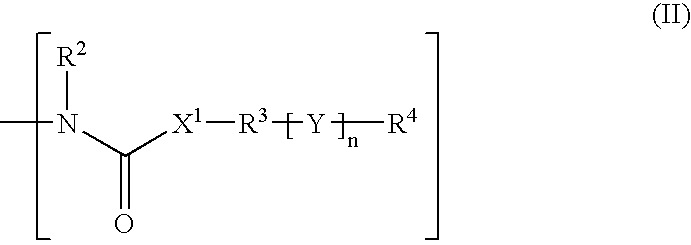Polymers and Their Use as Coatings
- Summary
- Abstract
- Description
- Claims
- Application Information
AI Technical Summary
Benefits of technology
Problems solved by technology
Method used
Image
Examples
example 1
Preparation of Urethane Containing Diol
[0079] Ethylene carbonate (160 g-1.82 moles) and toluene (200 g) were stirred together and heated to 50° C., creating a homogeneous mixture. Ethylene diamine (54.6 g to 0.91 moles) was added dropwise, maintaining the temperature below 60° C. The reaction mixture was separated into two phases and a white solid separated from the reaction mixture. Toluene was removed by evaporation yielding 208 g of a white powder, mp 92-93° C.
[0080] The white powder (70 g) was charged to a reactor, followed by caprolactone (202.9 g) and heated, with stirring, to 110° C. 0.1 g of stannous octoate was added and the consumption of caprolactone monitored by thin layer chromatography. Reaction temperature was maintained at 110-120° C., with subsequent additions of stannous octoate as required to maintain progress of reaction. When all caprolactone was consumed, the reaction was cooled and the contents discharged. On cooling the material became a waxy solid with the...
example 2
Preparation of Urethane Containing Diol
[0081] 1,6-Hexanediamine (91.8 g-0.79 moles) and toluene (200 g) were stirred together and heated to 50° C., creating a homogeneous mixture. Ethylene carbonate (140 g-1.59 moles) was added dropwise, maintaining the temperature below 60° C. The reaction mixture was separated into two phases and a white solid seperated from the reaction mixture. Toluene was removed by evaporation yielding 228.1 g of a white powder mp 92° C.
[0082] The white powder (40 g) was charged to a reactor, followed by caprolactone (94.3 g) and heated, with stirring, to 120° C. 0.1 g of stannous octoate was added and the consumption of caprolactone monitored by thin layer chromatography. Reaction temperature was maintained at 110-120° C., with subsequent additions of stannous octoate as required to maintain progress of reaction. When all caprolactone was consumed, the reaction was cooled and the contents discharged. On cooling the material became a waxy solid with the foll...
example 3
Curing of Urethane Containing Diol of Example 1
[0083] A coating formulation was prepared by mixing together the following components:
Material prepared according to Example 19.27%Desmophen A870 (hydroxyfunctional acrylic polyol38.32%available from Bayer)Cymel 303 (melamine based crosslinking agent13.53%available from Cytec)Nacure 2530 (catalyst, available from King industries)0.78%Triethanolamine0.40%Methoxypropylacetate (solvent)18.84%Methoxypropanol (solvent)18.84%
PUM
| Property | Measurement | Unit |
|---|---|---|
| Equivalent mass | aaaaa | aaaaa |
| Equivalent mass | aaaaa | aaaaa |
| Fraction | aaaaa | aaaaa |
Abstract
Description
Claims
Application Information
 Login to View More
Login to View More - R&D
- Intellectual Property
- Life Sciences
- Materials
- Tech Scout
- Unparalleled Data Quality
- Higher Quality Content
- 60% Fewer Hallucinations
Browse by: Latest US Patents, China's latest patents, Technical Efficacy Thesaurus, Application Domain, Technology Topic, Popular Technical Reports.
© 2025 PatSnap. All rights reserved.Legal|Privacy policy|Modern Slavery Act Transparency Statement|Sitemap|About US| Contact US: help@patsnap.com



